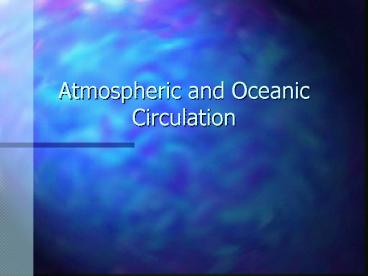Atmospheric and Oceanic Circulation - PowerPoint PPT Presentation
1 / 32
Title:
Atmospheric and Oceanic Circulation
Description:
A non-rotating Earth would have only two cells. Coriolis effects deflect to the right of the direction of ... 1 Dobson Unit = 2.69X1016 molecules Ozone cm-2 ... – PowerPoint PPT presentation
Number of Views:196
Avg rating:3.0/5.0
Title: Atmospheric and Oceanic Circulation
1
Atmospheric and Oceanic Circulation
2
Heating of the Earths Surface
3
(No Transcript)
4
Energy Balance by Latitude
AC p56
5
A non-rotating Earth would have only two cells
6
(No Transcript)
7
Coriolis effects deflect to the right of the
direction of motion in the Northern Hemisphere
8
(No Transcript)
9
(No Transcript)
10
World Rainfall
11
Inter-tropical Convergence Zone
12
Stratospheric Circulation
Circulation caused by differential heating of the
stratosphere
km
13
Dry adiabatic lapse rate
The expansion causes cooling.
The rate at which the temperature of the dry air
falls with height when heat is neither added or
subtracted is called the dry adiabatic lapse rate
-100C km-1
Rising air expands to reach the same pressure as
surrounding air.
Air rises
14
Moist adiabatic lapse rate
Why is the lapse rate for moist air -6.50C (i.e.
less than the dry rate)?
15
Temperature of atmosphere
Lapse rate
Patterns of smoke plumes
16
Temperature structure of the Atmosphere
0.1 mass aerosol lifetime 1-3 years. Unstable
19.9 mass aerosol lifetime 1-3 years. Very
stable
80 mass aerosol lifetime 10 days Strong
vertical mixing
17
The Stratosphere
- The stratosphere is a region of stability -the
temperature increases with height - Material directly introduced will stay there for
months, changing altitude slowly - Largely devoid of clouds - air is very dry and
clean - due to precipitation processes lower down.
18
The Tropopause
- Higher at the tropics 16-18km (c.f. 8-12km in
temperate regions - stronger convection enables air to climb higher
into the temperature inversion existing in the
stratosphere - transfer of air across boundary
19
Ozone distribution
1 Dobson Unit 2.69X1016 molecules Ozone
cm-2 100DU gives a 1mm thick layer at standard
pressures and temps
20
Regional patterns
21
Monsoons
Onshore/offshore breezes on a large scale
22
Precipitation Variability
- Warming will cause an increase in the Asian
summer monsoon precipitation variability - Changes in the monsoon duration and strength
depend on the details of the emission scenario.
23
Intertropical Convergence Zone Seasonal Variation
Lack of rain Dec-April
Lack of rain Dec-April
Our winter
24
Surface Ocean Currents
Some models predict significant slowing of the
gulf stream
25
Wind drives waves, ocean currents and heat
interchange between atmosphere and ocean.
Blue 1-4 ms-1 gray, 4-6ms-1 red, 6-16 ms-1
yellow16-20 ms-1.
Low pressure clockwise swirl
NASA/EOS image from http//eospso.gsfc.nasa.gov/eo
s_edu.pack/p13.html
26
The image is based on more than 150,000 satellite
measurements made during a single day in 1978 by
a "scatterometer" instrument on the Seasat
satellite. The Seasat scatterometer used a radar
beam to measure the roughness of the sea surface,
which is caused by wind action. Roughness
patterns were then used to derive the wind speeds
and directions shown here.
27
Thermohaline Circulation
Most models predict a slowing of the circulation
28
Net Poleward Energy transport
AC p56
29
Slowing of the thermohaline circulation
- Impacts deep-water oxygen levels and carbon
uptake by the oceans - Reduces heat transport in to higher latitudes of
the Northern Hemisphere - Beyond 2100 the circulation could completely shut
down if radiative forcing is large enough
30
Atmospheric motion time scales
- Lower troposphere horizontal flow 5ms-1 100s
km in a few days - insoluble, low reactivity
species transported across continents. SO2, NO2 -
acid rain, Sweden and Canada - Middle to upper troposphere strong winds move
constituents great distances - Saharan dust to
Florida, China desert dust to Hawaii or Alaska - Inter-hemisphere mixing is slow - exchange times
of about a year - species with low residence
times emitted in one hemisphere do not cross to
the other.
31
Volcanoes inject dust and gases into the
stratosphere - transported at 25ms-1 around the
world
32
Troposhere-Stratosphere mixing
- Mixing strongly inhibited - periods of several
years - Most transport across the regions is by injection
into stratosphere by upward turbulence and return
near jet stream tropopause folds in the
mid-latitudes































